EFFECT OF THE AXIAL CLEARANCE ON THE PERFORMANCE CHARACTERISTICS OF A LOW-FLOW REACTION TURBINE
Keywords:
radial-flow reaction turbine, clearance, combined parameters, characteristics, degree of pressure reduction, expansion work, rotation frequency, aggregate composition, scheme.Abstract
DOI: https://doi.org/10.15407/itm2025.01.017
This study is concerned with a stage of a radial low-flow reaction turbine, which is used in aircraft engines, propellant feed systems of rocket engines, turbocharging systems of internal combustion engines, etc. The goal of the study is to investigate the effect of the clearance between the impeller and the stationary housing of a radial-flow turbine on its power parameters. The paper shows the need to refine, supplement, and sort parametric data on the effect of the axial clearance between the free edge of a radial-flow turbine impeller blade and the stationary housing on the turbine power parameters. It is shown that clearances in the turbine setting play an important role in the working process and significantly affect the key performance characteristics. The correctness of the methodological approaches to the tests and experimental studies conducted is verified by the results of other authors. The studies were conducted in two stages. At the first stage, a turbine stage was tested as a part of a single model gas-dynamic circuit with a compressor stage and a combustion chamber. At the second stage, tests were carried out with two independent gas-dynamic ducts of the turbine and compressor, in which the working fluid was supplied to the units separately, with the possibility of flow rate control.
The novelty of the study consists in obtaining new data on the effect of the axial clearance in small-sized radial low-flow turbines on the key power and performance parameters of the stage. In the study, generally accepted methods of experimentation and data processing were used. The obtained results allow one to relate the parameters of the expansion process in reaction gas turbines to the axial clearance value.
The practical value of the results lies in the possibility of using the obtained experimental data in designing low-flow impeller machines for jet engines and in refining computational methods.
REFERENCES
1. Lokai V. I., Maksutova M. K., Strunkin V. A. Gas Turbines of Aircraft Engines: Theory and Design. Moscow: Mashinostroyeniye, 1979. 447 pp. (In Russian).
2. Kholshchevnikov K. V., Emin O. N., Mitrokhin V. T. Theory and Design of Aircraft Impeller Machines. Moscow: Mashinostroyeniye, 1986. 432 pp. (In Russian).
3. Lattime S .B., Steinetz B. M. High-Pressure-Turbine Clearance Control Systems: Current Practices and Future Directions. Journal of Propulsion and Power. 2004. V. 20. No. 2. Pp. 300-311.
https://doi.org/10.2514/1.9255
4. Нoward W. D., Fasching W. A. CF6 Jet Engine Diagnostics Program; High Pressure Turbine Roundness/Clearance Investigation. NASA CR-165581. 1982. 123 pp. https://ntrs.nasa.gov/citations/19830004830 (Last accessed on January 7, 2025).
5. Hourmouziadis J., Albrecht G. An Integrated Aero/Mechanical Performance Approach to High Technology Turbine Design. MTU, 1988. 12 pp. https://apps.dtic.mil/sti/citations/ADP006200 (Last accessed on January 7, 2025).
6. NASA/PWA Energy Efficient Engine. High Pressure Turbine Detailed Design Report. NASA CR-165608, 1984. 178 pp. https://ntrs.nasa.gov/citations/19840020719 (Last accessed on January 7, 2025).
7. NASA/GE E3 Flight Propulsion System Final Design and Analysis. NASA CR-168219, 1985. 174 pp. https://ntrs.nasa.gov/citations/19900019242 (Last accessed on January 7, 2025).
8. Wiseman M. W., Guo T. An investigation of life extending control techniques for gas turbine engines. Proceedings of the American Control Conference, Arlington, VA, June 25 - 27, 2001. https://ieeexplore.ieee.org/abstract/document/946211 07.01.2025 (Last accessed on January 7, 2025).
9. Theory and Design of Air Breathing Engines. S. M. Shlyagtenko (Ed.). Moscow: Mashinostroyeniye, 1987. 568 pp. (In Russian).
10. Tractor and Combine Diesel Turbochargers. Overhaul Specifications TK10-05.0001.054-83, TK 70.0001.100-80, and TK 70.0001.083-78. Moscow: GOSNITI, 1988. 54 pp. (In Russian).
11. GOST ISO 1940-1. 2007. Interstate Standard. ISO 1940-1:2003. Mechanical Vibration - Balance Quality requirements for Rotors in a Constant (Rigid) State - Part 1: Specification and Verification of Balance Tolerances (IDT). Standartinform, 2008. 27 pp. (In Russian).
12. Diesel and Gas Engine Turbochargers. General Specifications GOST 9658-81. Moscow: USSR State Committee on Standards, 1988. 13 pp. (In Russian).
13. Sorokin V. G. et al. Steels and Alloys: Grades. V. G. Sorokin, M. A. Gervas'ev (Eds.). Moscow: Intermet Engineering, 2001. 608 pp. (In Russian).
14. Zubchenko A. S., Koloskov M. M., Kashirsky Yu. V. et al. Steel and Alloy Grades. A. S. Zubchenko (Ed.). Moscow: Mashinostroyeniye, 2003. 784 pp. (In Russian).
15. Baikov B. P., Bordukov V. G., Ivanov P. V., Deich R. S. Diesel Turbochargers: Handbook. Leningrad: Mashinostroyeniye, 1975. 200 pp. (In Russian).
16. Rozenberg G. Sh., Tkachev N. M., Kostrykin V. F. Marine Centripetal Turbines. Leningrad: Sudostroyeniye, 1973. 216 pp. (In Russian).
17. Savel'ev G. M., Lyamtsev B. F., Aboltin E. V. Experience in Automobile Diesel Turbocharger Refinement and Production. Moscow: 1985, 94 pp. (In Russian).
18. Mezheritsky A. D. Marine Diesel Turbochargers. Sudostroyeniye, 1971. 192 pp. (In Russian).






